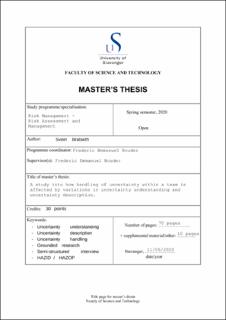| dc.description.abstract | The background for this thesis came from a belief that there might be different interpretations of the concepts of uncertainty within a team discussing uncertainty. This might be especially evident in Hazard Identification (HAZID) and Hazard Operability (HAZOP) risk assessments where participants with different backgrounds are gathered on purpose to highlight different points of view. This led to the following research question “How variations in uncertainty understanding and uncertainty description affect how uncertainty is handled within a team?”. The question was investigated through a literature review of relevant schools of thought along with different uncertainty handling strategies. The understandings within the team were assessed through grounded research with prolonged semi-structured interviews. To not assess all possible backgrounds a cross-section of a team consisting of engineers, economists, risk practitioners, and other individuals not considered in the beforementioned categories were considered. The cross-section of the team assessed consisted of 6 engineers, 2 economists, 3 risk practitioners, and 2 others with a background as manual labour and public administration, 13 persons in total. The different schools of thought were engineering and technical studies, expected utility theory, risk theory, and subjective expected utility theory respectfully.
From the literature review, it is evident that there are many different uncertainty understandings and measures depending on the background i.e. there are many different schools of thought. This is made even more intricate by the fact that a single individual may have changing and at times conflicting understandings of uncertainty. From this finding, it is surprising that the interview subjects provided a fairly coherent understanding and measure of uncertainty. The majority stated that they understand and measure uncertainty through probability. However, the difference lay in the description. All of the interviewees claimed to use subjective probability even though this is not allowed in expected utility theory where only frequentist probability is allowed. The relevant interviewees said that frequentist probability is sometimes used as a basis for the final subjective probability. However, the mindset is still on frequentist probability. All the other schools of thought allow for and use both subjective and frequentist probability. The evaluation and inclusion of rare events are difficult in general and all interviewees agree, there is not enough imagination to visualise these outcomes. Frequentist probability, i.e. expected utility theory, ignore these events, the interviewee confirms this. Subjective probability, i.e. all the other schools of thought, may take it into consideration however, low assigned probability often results in it being ignored. Except for risk theory, through the managerial review and judgment step, rare events with low probability and limited knowledge may be included. However, none of the risk practitioners state that this is done.
The literature on attitude and handling of uncertainty falls along the lines of reduce, tolerate, and denial this was confirmed by all of the interviewees with that exact prioritisation. Reduce uncertainty as fare as possible, then create plans to manage residual uncertainty, finally decide to go or nogo. Interviewees said that reduction is done by gather information. The new information may take on different meanings depending on the background. For frequentist probability, new information may confirm existing data, however, new rare events may not be captured. For subjective probability, new information may provide confidence in assigned probability and new rare events. None of the interviewees mentioned having experienced a conflict of action regarding this. An observation was that a few interviewees claimed that at times it might be desirable to increase uncertainty to look for new options. These were not along the lines of the schools of thought, but more client and contractor.
During HAZID and HAZOP type risk assessments, there are most likely different perceptions of uncertainty. To align these a project-specific guideline detailing the different concepts on uncertainty description, how to take into consideration rare events, handling uncertainty may be considered to avoid confusion, miscommunication, and to align expectations, and ultimately may also avoid rare unwanted events. Such a guideline may also be useful for persons looking into the assessment after the fact. Considering establishing such a guideline is the result of this grounded research. | en_US |

